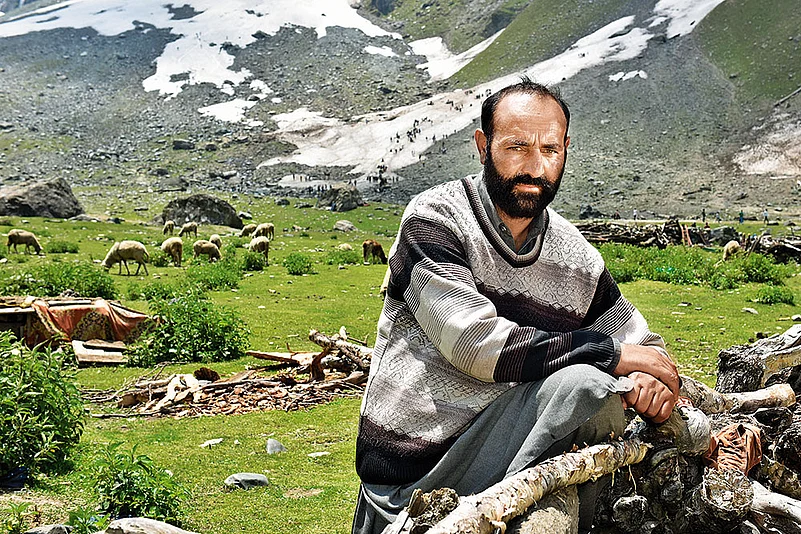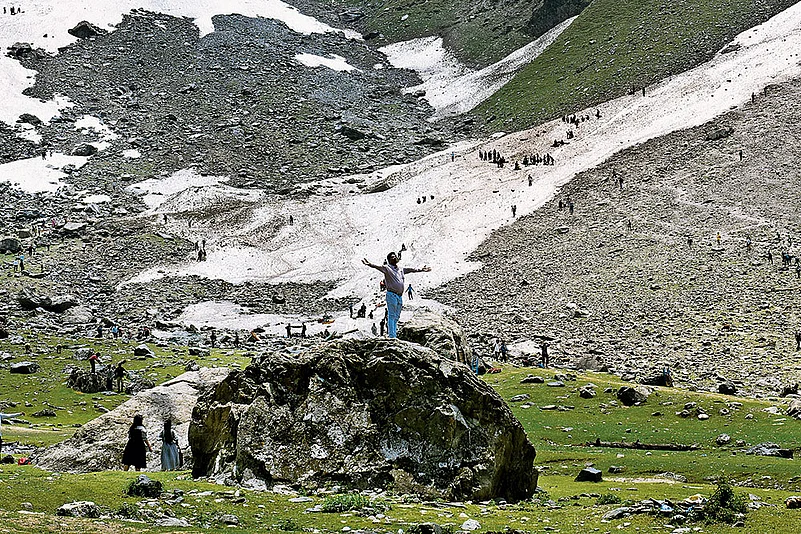The two-hour climb up the Thajiwas Glacier is punishing, even for ponies familiar with the trail. Ferrying tourists on their backs, the frail ponies ascend on a stone-paved path, instinctively seeking soft patches of earth to secure a grip for their weary hooves. They wrestle with pain and the strain of their carriage, as they navigate the path, dodging tricky stones and boulders along the way.
After the arduous climb, horsemen, who also serve as guides, halt the ponies at the peak and announce: “This place is called Hazroon Saal Ka Baraf (Thousands of Years of Snow).”
Ironically, despite its name, no snow is visible along the riverbank deep below, where the Thajiwas glacier water flows into the fast-moving Sindh River. Neither is there snow on the high mountains of the Thajiwas glacier, which sits at an altitude of 9,186 feet and attracts thousands of visitors every day, looking forward to the thrill of a sledge ride downhill.
But tourists on ponies continue to ascend from the peak to the Thajiwas meadow through tough terrain. The horseman occasionally points to two snowless peaks, saying, “Those are the original Thajiwas Glacier peaks, now called Down Thajiwas.” The mounted posse of tourists continues onward.
Once the stony path ends, the Thajiwas stream appears in the meadow. Ignoring their riders, ponies head straight to the stream to drink, sometimes triggering panic among tourists riding them. To the right, shepherds tend their herds. Ahead, locals have set up makeshift coffee and Maggi shops and offer guided sledge rides. The Thajiwas Glacier has become a bustling tourist spot with visitors haggling over prices, taking selfies and negotiating with sledge drivers and guides, at the glacier’s foothills.
Glaciers appear to be the newest offering in Kashmir’s bouquet of tourism experiences.
Kartar Singh, 50, from Manali, sells shilajit, a powerful rejuvenating natural resin, directly to tourists from his shoulder bag. He discreetly offers them samples, explaining its benefits: boosting energy, reducing cholesterol and aiding joints. Despite his assurances and explanations, younger listeners, aware of shilajit’s reputation as a natural Viagra, taste it, but move on without buying. But Singh remains undeterred.
He sells each packet of shilajit for Rs 300 to Rs 400, averaging two to four sales daily. “That’s enough for me,” he says contentedly. The glacier, he says, was once covered with snow. “I have been here for the past 20 days. I interact with the locals, and they tell me about the glacier and how it used to be.”
After finishing his day’s work, Singh claims he treks to near the Baltal base camp for night shelter along with Amarnath yatris (pilgrims). However, Baltal base camp near Zojila annually hosts lakhs of yatris amidst strict security protocols, allowing only registered pilgrims. Over one lakh yatris have visited the camp by June 4.
Unlike Singh, on the right end of the Thajiwas meadow, Abdul Rashid Chopan lives with his wife and daughter in his behak. The Chopans, like the Gujjars, are shepherds who migrate to higher reaches and stay in behaks, temporary shelters built from wood, stone, mud and thatch, traditionally used by nomadic pastoralists, while grazing livestock.
The Chopans do not own livestock. Instead, they care for local farmers’ sheep for Rs 300-350 per head per season. However, expanding roads and tourism have disrupted the traditional lifestyle of the nature-harmonious Chopans.
Thajiwas is dear to Rashid. “This place was sacred. I was born in these meadows. My father, Abdul Razak, and my grandfather, Abdul Aziz, were also shepherds. We used to bring around 5,000 sheep here, but now everything has changed,” he says, leaning against his behak.
“We now bring only 400 sheep,” he adds. Rashid says the meadow has shrunk like the glacier. Over the past decade, tourism influx has replaced traditional pastoral jobs for the Chopans, who now cater to herds of tourists, instead of tending to sheep. He recalls a 1996 thunderstorm that created the current stream.

“The Thajiwas stream was full of water, and it was very difficult to cross it. Now, the stream is called ‘Hotel Stream’ because many hotels have sprung up on the Thajiwas side,” says Rashid.
“Tourism has brought money to the area, creating employment and daily wages,” says Rashid. “It is the real business here now. We have lost our meadows, and I think after a year or so, I will also give up rearing my herd.”
The change is not merely restricted to Rashid’s lifestyle.
Thajiwas is now a mere glacial remnant and will soon disappear. Once dominating the gorge, it is rapidly receding due to excessive tourism.
The panoramic landscape, which he is nestled in, has changed too. “I have visited all parts of Thajiwas, Zaldardub, Abjupather and Nawikan—but they are no longer glaciers. You don’t see much snow there anymore,” he says.
Irfan Rashid, a geoinformatics professor at the University of Kashmir, notes significant glacier retreat in the region. Thajiwas, once a large glacier extending to Sonamarg, has receded 12-15 metres annually since the 1960s. He attributes this to climate change, with insufficient winter snowfall and higher summer temperatures.

Local efforts like restricting vehicular access to Thajiwas meadow can help mitigate the crisis, says Rashid. Glaciers such as Machoi, Kolahoi and Thajiwas are vital water sources. His research shows a 23 per cent reduction in Kolahoi Glacier since 1962 and a 29 per cent loss in Machoi Glacier from 1972 to 2019.
Advertisement
Experts say Thajiwas is now a mere glacial remnant and will soon disappear. Once dominating the gorge, it is rapidly receding due to excessive tourism. They argue that its melting can only be slowed if authorities intervene and stop exploiting the glacier for recreational purposes.
The receding glaciers are impacting the rivers.
According to the Jammu and Kashmir Rivers Report, over the past 51 years, the glacier area in the Jhelum basin has shrunk from 46.09 km2 in 1962 to 33.43 km2 in 2013, marking a 27.47 per cent decline.
High levels of black carbon in the Kashmir valley exacerbate glacier depletion. It seems tourism has Taken over everything.
Advertisement
High levels of black carbon (5.9 mgm-2) in the Kashmir valley exacerbate glacier depletion. Rashid highlights its visible impact on rivers like Sindh, Ferozpur nalla, the Rimbiara river and the Kolahoi valley. Development activities, particularly in Sonamarg, have expanded built-up areas far beyond sustainable limits, with 224.1 hectares of built-up and green areas and 78.49 hectares of purely built-up land exceeding ecological thresholds.
It seems tourism has taken over everything.
On the afternoon of July 3, Mohammad Shafi Tulaili, 65, and his four colleagues were visibly angry as they sat near a stream in the Thajiwas meadow. “They (the authorities) don’t want us to earn anything from tourists; they are forcing them out of here since the yatra started,” says Tulaili.
Advertisement
He was upset because the police had ordered tourists to leave the area as part of a security drill for the Amarnath Yatra. During the yatra season, tourists are not allowed at Thajiwas after 2 pm.

Tulaili and his friends are climate migrants. About 50 years ago, they left the Tulail Valley, located on the Line of Control (LoC), around 200 km northwest of Srinagar, because the road to Tulail used to remain closed for six months annually, limiting access to medical and educational facilities.
They moved to Kullan in Kangan, around 34 km from Sonamarg, buying one kanal (5,445 square feet) for Rs 3,000 to Rs 5,000. Tulaili says snowfall in the region has decreased compared to earlier years. “In June, the meadow used to have snow all around, but we don’t see that much snow these days,” he adds.
Advertisement
“We assist tourists in reaching the mountain and ensuring they can safely and easily use sledges to have a snow ride down the slope. We charge them between Rs 100 and Rs 200. I have been doing this for the past 22 years. We have seen the rush increase over the past four years, which benefits locals. Our livelihood depends entirely on tourism,” he adds, even as a Taiwanese tourist wanders through the meadow, seemingly mesmerised by its beauty, but equally amused by the rush of visitors.
Botiya Chedwa, 76, from Mamwar village in Kangan, grew up in the jungle. Named Botiya, a local reference for herbs, by his father, he’s guided sledge rides for years amidst the sharp glacial area decline. He loves tourism, but laments, “The stream is cluttered with polythene and empty bottles of soft drinks, but still, tourism is our livelihood.”
Advertisement
Along Sindh’s tranquil banks near Rezan village, Ghulam Mohammad Bhat, 76, relocated from Gurez 50 years ago, sits alongside Haji Mohammad Jamal Raina, 70. Bhat recently moved here after a landslide destroyed his Rainapati home last year. Reflecting on the disaster, Raina says, “When the landslide came, I couldn’t understand how we survived. We lost everything. I was deeply attached to my birthplace. It has now gone.” Rainapati, three km from Rezan across the Sindh River, remains in his thoughts. He blames road construction in the mountains, insisting, “When the mountain came down, there was no rain.”
When Bhat first arrived in Rezan, there were only eight houses in the village and its vicinity. He purchased around 12 kanals of land after selling a large portion of his property in the Gurez Valley along the LoC, buying each kanal for Rs 3,000. “Life used to be simple here. We produced everything except rice. But now tourism has taken over,” he says. His son now works at Zero Point across the Zojila as a tourist guide.
Advertisement
Now, hotels have come up in the village run by big hoteliers and bureaucrats. “It has made our lives difficult. The land prices due to these hotels have gone up. We are unable to buy land for children in our village as prices have gone up and people from Srinagar and other places have bought land here for investment,” says Mohammad Sultan Bhat, 65.
Further down from Rezan, in Wussan village, the impact of receding glaciers and the rapidly changing Kashmiri society, is evident.
Ali Mohammad Mir, a farmer for 50 years, has seen land holdings shrink and water sources recede. The Vishnu Sar stream is drying up, lowering the water table. Along the Sindh River, outsiders have bought large portions of paddy land but left it unused, awaiting construction.
Advertisement
In his village, streams once fed by glaciers are drying, forcing him to convert his rice fields in Wussan into apple orchards. Initially satisfied, Mir now sees even the orchards suffering due to reduced precipitation. With only a few kanals of rice fields surviving, he believes these are the last days of rice cultivation in Wussan as the water table drops and land is sold to hoteliers. “Having paddy land has now become a liability. I am holding on for now, but I don’t know for how long,” he adds.
Naseer Ganai in Sonamarg
(This appeared in the print as 'Ice Loss')




















